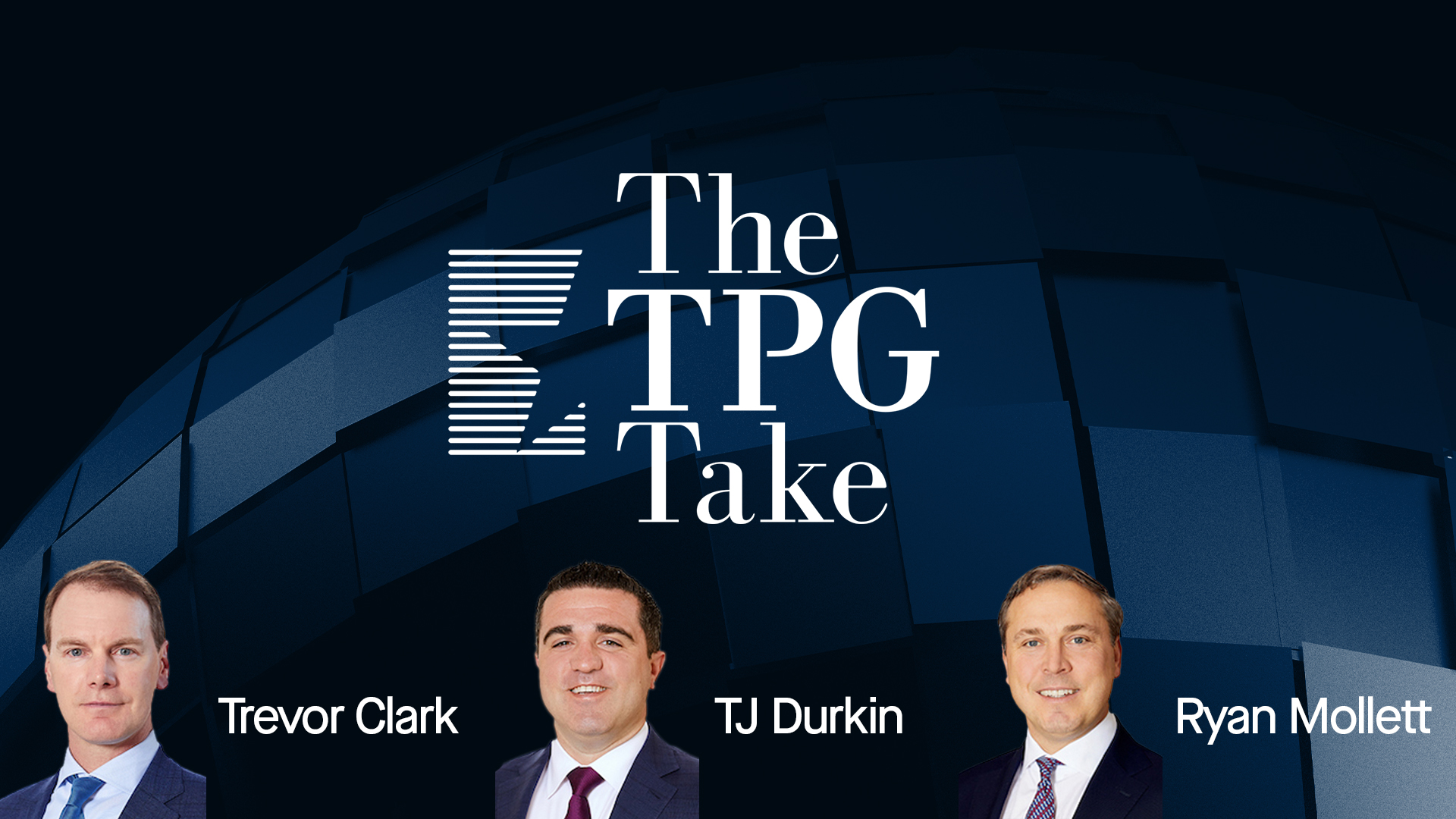
June 2025, Issue #12
Navigating the Future of Credit Markets: Perspectives from TPG Angelo Gordon and Twin Brook
In our latest issue of The TPG Take, leaders across TPG Angelo Gordon and Twin Brook share insights into navigating today’s dynamic credit landscape.
From solving complex challenges with bespoke financing solutions to the benefits of deep sector expertise across our strategies, they highlight our approach and the opportunities within credit solutions, structured finance, and direct lending.
The Case for the Lower Middle Market Direct Lending
Trevor Clark: "Today, when people talk about the middle market, in general, they're talking about companies in the private sector who aren't doing public executions in the lending space of $200 million of cash flow and below. Our focus on the lower middle market after 20 years isn't by accident, it's very intentional."
Drew Guyette: "Part of the reason is the lower middle market benefits from more conservative structures. There's a truer sense to the underwriting process and the credit wherewithal of the borrower, lending itself to true cashflow generation being the definition of how you quantify the amount of appropriate debt that a business can actually handle. As a result, generally speaking, lower middle market borrowers will come into these moments of uncertainty and have a lower absolute leverage level, a higher quality to the definition of their EBITDA, thus resulting at a higher quality to the interest coverage ratio or the fixed charge ratio associated with that borrower."
Grant Haggard: "We've been through a lot of economic cycles together whether it was the GFC or COVID, and we believe we've built a business in an organization to withstand whatever comes our way. It comes down to picking the right private equity sponsors, structuring your deals appropriately, diversity of borrowers, and diversity of industries."
Kim Trick: "I think this is when lender relationships become stronger. As I look back at the period following the GFC, the groups that had capital and relationships were the ones that really capitalized. So, I think with disruption comes opportunity. The importance of the relationships that we have with our private equity firms and our borrowers, and how we respond in those situations is when a strong relationship can become even stronger. And we have a lot of experience working through those periods of distress."
Grant Haggard: "What we're watching closely is to have a little more clarity around policy, which we think will create more certainty and a better environment for companies to be sold, whether it's a private equity firm or a privately held company. Until then, we're challenged with the current market conditions in terms of slower M&A volume. There’s still a lot of pent up demand for private equity firms to sell their companies, for private owners to sell their businesses."
Drew Guyette: "The current interest rate environment is something that for many of us in our 20+ year careers have seen – a higher base rate environment and a spread premium associated with risk. So this isn't uncharted territory – this is a moment when fixed income matters again."
Trevor Clark: "When you bring periods of economic stress to a lender, you're highlighting your ability to continue to perform even in those tougher market environments. It takes those periods where there is a little bit more economic chop to really have those differences highlighted."
Unlocking Value with Structured Credit and Specialty Finance
TJ Durkin: "Structured credit and specialty finance is covering all the asset classes outside of traditional corporate credit or EBITDA – from large, economically core asset classes to Main Street. It ranges from things most people touch every day like auto or mortgage loans, all the way out to things small businesses need like equipment financing, for example. We're providing capital in both the public and private markets to facilitate that economic activity."
Aaron Ong: "These are asset classes that are so fundamental to everyday life that it's hard to realize how big they actually are. Once you zoom out and realize that there are 150 million working class Americans, you're all of a sudden in the trillions."
Marc Lessner: "It's a $14 trillion market versus the corporate market, which is sub $2 trillion. It provides diversification from EBITDA lending and corporate finance, and allows you to invest within the U.S. consumer for access to cash flows and liens off of real assets that you would not otherwise have access to."
TJ Durkin: "As GDP grows, asset-backed credit grows – it's directly linked to Main Street economic activities. Where we're really seeing growth is the shift out of credit creation, historically, living on bank balance sheets, and moving into the non-bank ecosystem."
Yong Joe: "If you think about what the banks are doing, there are two forms of white space being created. There's the retrenchment of banks from certain asset classes, but there's also increased bank consolidation. This is where our capital can step in to fill those gaps and find a flexible, creative solution for these counterparties who want to diversify their financing from having to rely on bank capital alone."
TJ Durkin: "We have many longstanding relationships going back five to ten years, so we may be a lender to a counterparty when bank capital is not sufficient. The shift from bank balance sheets to non-bank origination companies has been occurring since the GFC – it's just been happening very organically, very slowly. Folks that were focused on it, like ourselves, have been playing a part in that growth."
Defining the Credit Solutions Opportunity
Ryan Mollett: "We define credit solutions as a company that has a complex problem that needs a solution, and that solution is provided through a credit instrument."
Brendan McCaffrey: "We're always starting with a blank sheet of paper. When we're engaging with an issuer, we're seeking to solve some kind of distinct, idiosyncratic challenge they're facing, and we come up with highly bespoke, customized solutions."
Ryan Mollett: "In 2020-2022, when valuations were very high, interest rates were very low – people built capital structures for a zero-interest rate environment. That clearly doesn't exist anymore, and what we're seeing now are spreads widening and access to the primary markets being shut down. Companies will need capital for refinancings, growth, acquisitions; and if they don't have access to that regular way market, they're going to come to a credit solutions provider."
Jake Gladstone: "As we think about being partners to companies, it's not only providing capital in a way that may not necessarily be available in other pockets of the market, but more importantly, truly being a partner to them. Post lending to a business, we work very closely with them in terms of what's going on in their companies and on ways we can provide incremental capital to help them meet their goals."
Joseph Lenz: "We have organized our business around domain and sector experts who understand the unique attributes of the industries they cover. The only way to recognize and understand inflection points is to cover sectors, companies, and management teams, because the capital that we provide is very responsive to the sector and to the company that we're looking to provide financing for."
Brendan McCaffrey: "In our business, we're almost exclusively focused on the opportunity set in either publics or privates. Having agnosticism across the two products is real edge when you're engaging with companies. I think you have this real convergence right now where the pipeline was already incredibly deep on the private side, which is only going to continue to grow in the face of volatility in public markets. But at the same time, we could have an opportunity to deploy capital in a meaningful way in public markets."
Ryan Mollett: "We're really excited about the necessity for our capital in the market, and how discerning we can be with where we are deploying that capital."
ICYMI: Other News & Views from TPG...
Recently, we had the pleasure of convening our ecosystem of investors, advisors, CEOs, and partners at our TPG Rise Annual Investor Meeting. Leaders from across our Rise and Rise Climate platforms reflected on the past decade of impact investing, and shared business updates and sector insights across healthcare, education, the energy transition, and more. Thank you to all who joined and we look forward to the next decade of progress!
We recently announced our agreement to carve out and acquire Sabre’s Hospitality Solutions business. The investment combines our decades of experience investing in technology, travel, and leisure to help establish the business as a leading independent hospitality tech provider. In the latest episode of Investment Insights, TPG Partners Tim Millikin and Paul Hackwell discuss the trends that drove the investment, and how we approach partnering with businesses like SHS to position them for long-term growth and success.
Thank you to all of our followers and readers for joining us for another edition of The TPG Take. Please share the newsletter with anyone you think would be interested and we look forward to being back in your inboxes.

TPG
345 California St suite 3300, San Francisco, CA 94104, USA
Important Disclosures
This material is solely for informational purposes and shall not constitute an offer to sell or the solicitation to buy securities. The opinions expressed herein represent the current, good faith personal views of the author(s) at the time of publication, and do not necessarily represent the views of TPG, its affiliates, or any of its investment professionals. The opinions expressed herein are not definitive investment advice and should not be relied on as such. The information presented herein has been developed internally and/or obtained from sources believed to be reliable; however, TPG does not guarantee the accuracy or completeness of such information. We provide links to third party websites only as a convenience and the inclusion of such links does not imply any endorsement, approval, investigation, verification or monitoring by us of any content or information contained within or accessible from the linked sites. If you choose to visit the linked sites you do so at your own risk, and you will be subject to such sites' terms of use and privacy policies, over which TPG has no control. In no event will TPG be responsible for any information or content within the linked sites or your use of the linked sites. Predictions, opinions, and other information contained in this material are subject to change continually and without notice of any kind and may no longer be true after the date indicated. Any forward-looking statements speak only as of the date they are made, and TPG assumes no duty to and does not undertake to update forward-looking statements. Forward-looking statements are subject to numerous assumptions, risks and uncertainties, which change over time. Actual results could differ materially from those anticipated in forward-looking statements.
